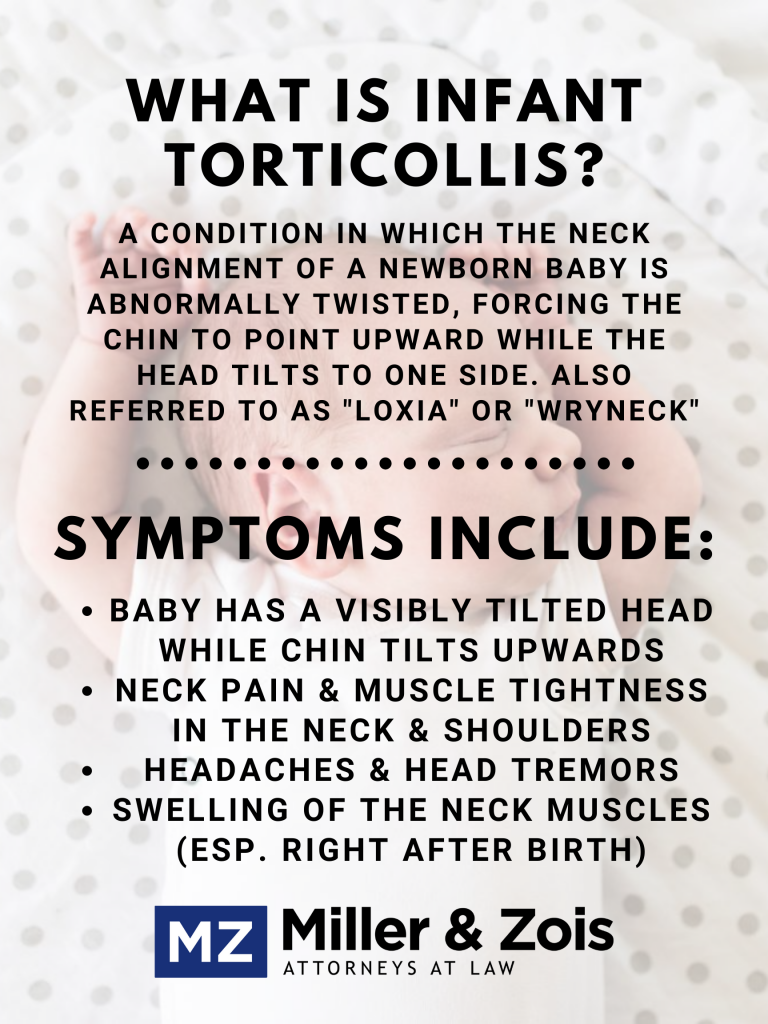Infant torticollis is a condition in which the neck alignment of a newborn baby is abnormally twisted, forcing the chin to point upward while the head tilts to one side. This condition is sometimes referred to as “loxia” or “wryneck.”
Torticollis is most frequently caused by physical trauma during childbirth. Approximately 1 out of every 250 babies born in the U.S. are affected by infant torticollis.
Many believe that torticollis is an injury that stems from a difficult delivery — which is often avoidable if the doctor meets the standard of care — that is also responsible for the brachial plexus palsy.
What Causes Torticollis in Infants?
 Infant torticollis is sometimes an inherited or congenital condition that babies are born with. In other instances, torticollis in infants can result from accidents or health conditions in early infancy. The most common cause of infant torticollis, however, is physical trauma experienced during childbirth. More common sources of birth injury or trauma that can cause infant torticollis include:
Infant torticollis is sometimes an inherited or congenital condition that babies are born with. In other instances, torticollis in infants can result from accidents or health conditions in early infancy. The most common cause of infant torticollis, however, is physical trauma experienced during childbirth. More common sources of birth injury or trauma that can cause infant torticollis include:
- Forceps Negligence: forceps are an obstetrical instrument sometimes used to manually assist or facilitate vaginal delivery. They look sort of like an enormous pair of pliers with padded spoon cups at the end that fit around the baby’s head. Using forceps requires a very high level of skill and precision by the doctor. A minor mistake, lack of care, or poor skills with forceps can easily result in physical injuries to the baby. Infant torticollis is one of the potential conditions that can result from forceps-related injuries during childbirth.
- Vacuum Extractor Negligence: a vacuum extractor is another common obstetrical tool used to assist with vaginal delivery. It has a handle with a suction cup that connects to a pump. The use of a vacuum extractor requires somewhat less skill and training than forceps, but there are several situations where using it can be dangerous for the baby. The overuse of the extractor can also be dangerous. Negligent use of a vacuum extractor can cause infant torticollis.
Symptoms of Infant Torticollis
The core symptom of infant torticollis is the characteristic titled head. The baby’s head will appear noticeably tilted to one side or the other at all times, while the chin angles upwards. This abnormal head alignment is the primary symptom of torticollis, but the condition can also cause secondary symptoms such as:
- Neck pain and muscle tightness in the neck and shoulders
- Headaches and head tremors
- Swelling of the neck muscles (especially right after birth)
How Is Infant Torticollis Diagnosed?
How Is Infant Torticollis Treated?
Is Infant Torticollis Permanent?
Contact Miller & Zois About Infant Torticollis
If your baby was born with infant torticollis, scoliosis, plagiocephaly, or other birth injuries, it may have been caused by negligent care during labor and delivery. The birth injury attorneys at Miller & Zois can help you investigate your case and determine whether you might have a claim for medical malpractice. Call our Maryland birth injury malpractice lawyers at 800-553-8082 today or get a free online consultation.
 Maryland Injury Law Center
Maryland Injury Law Center


